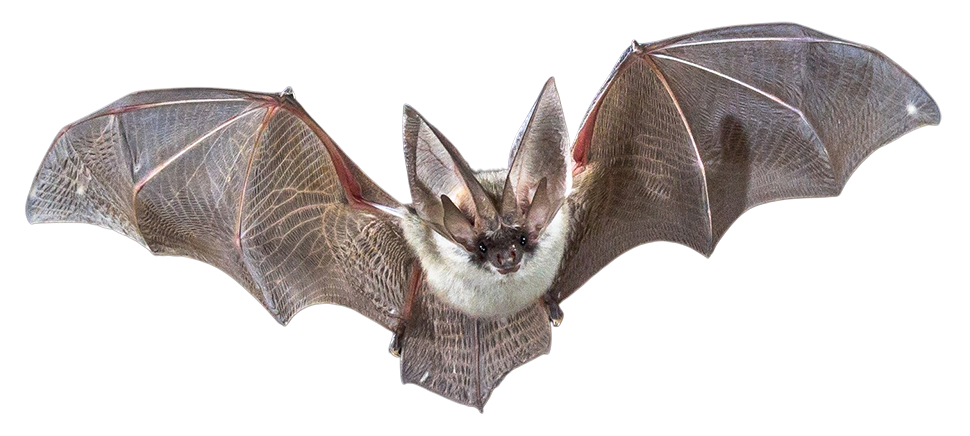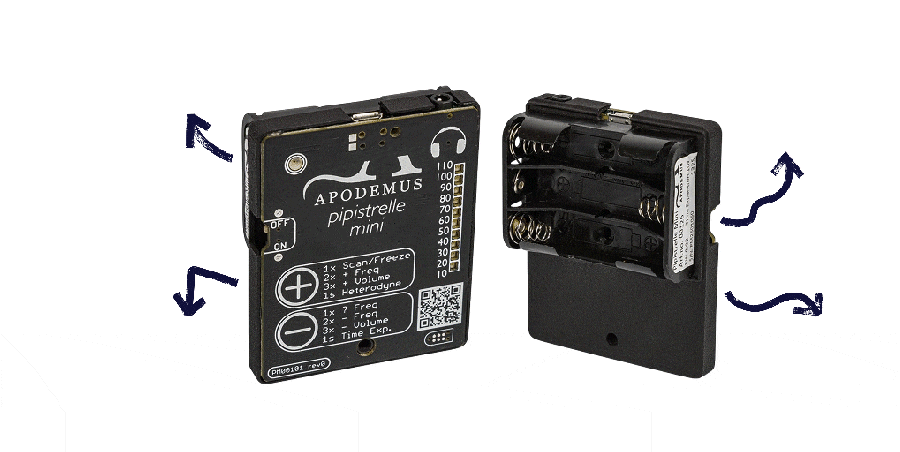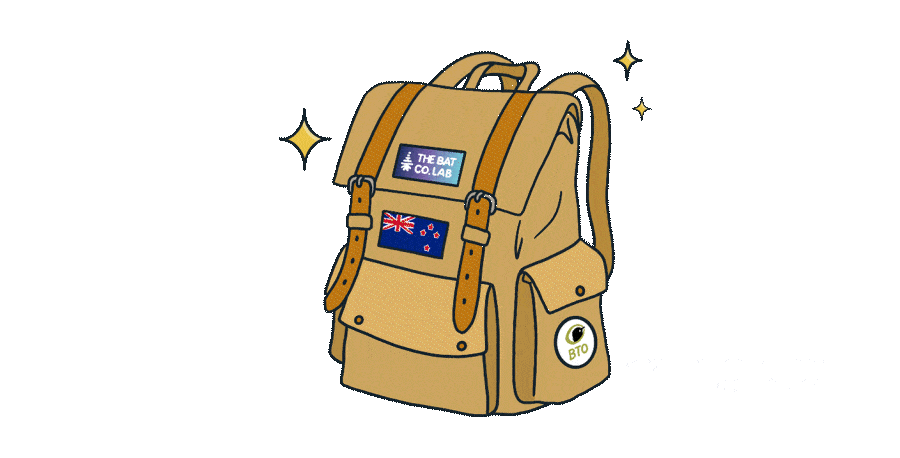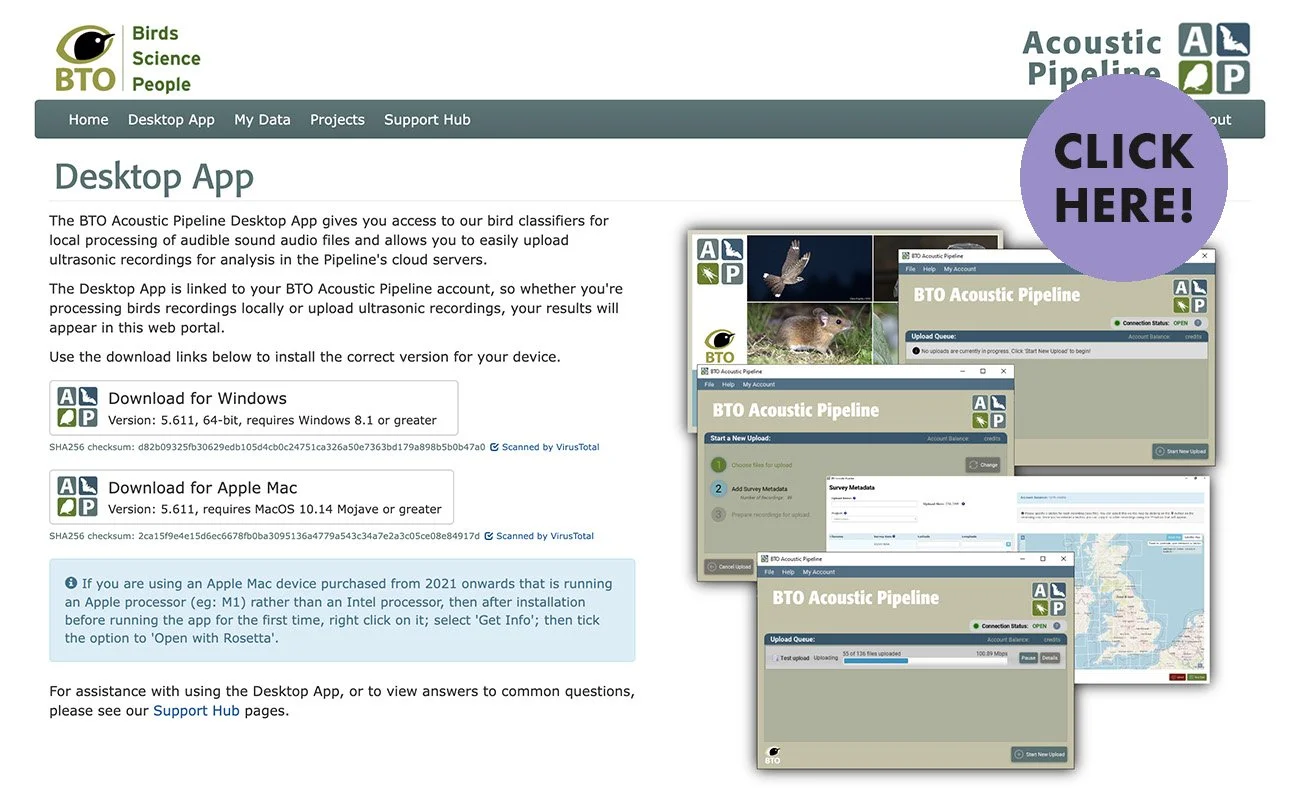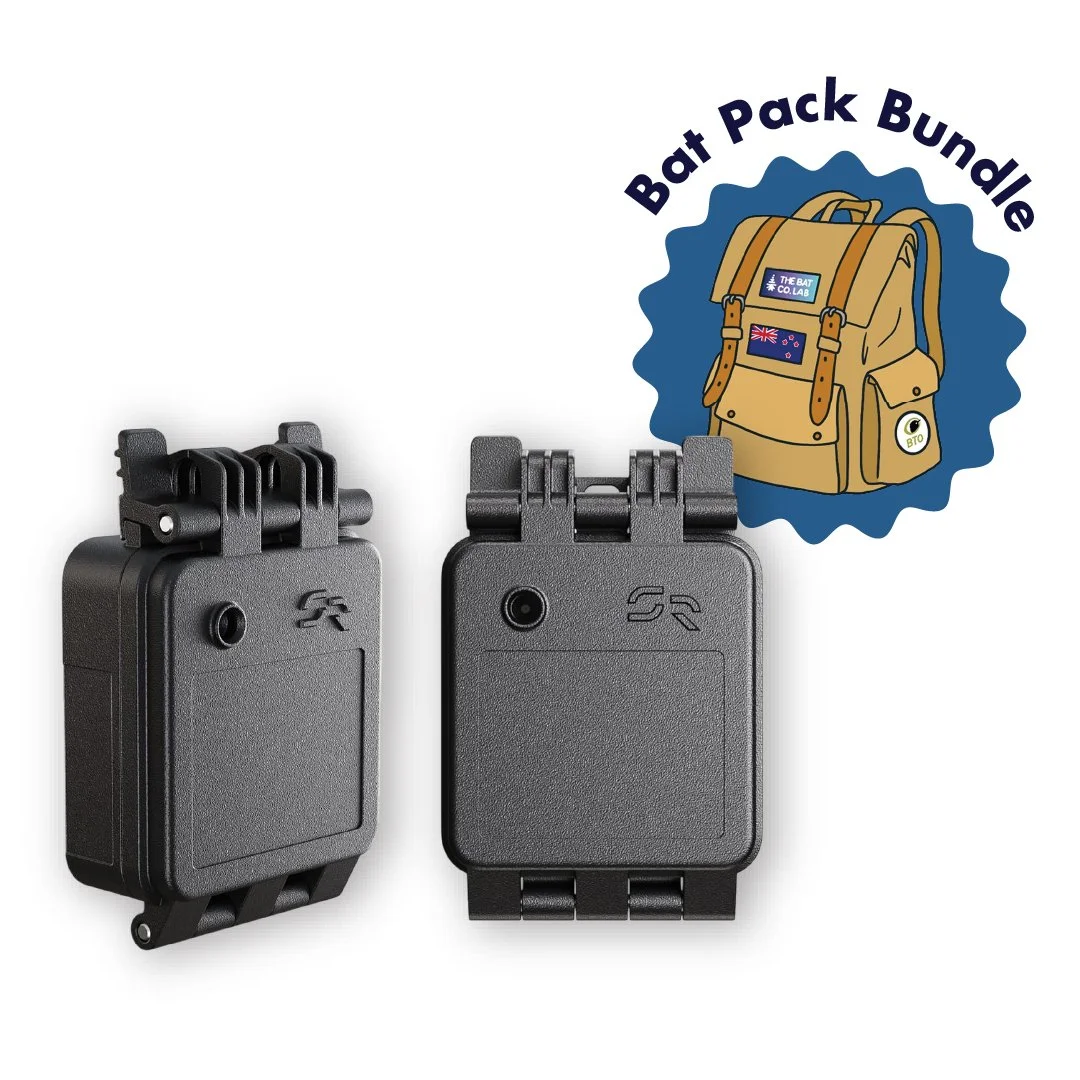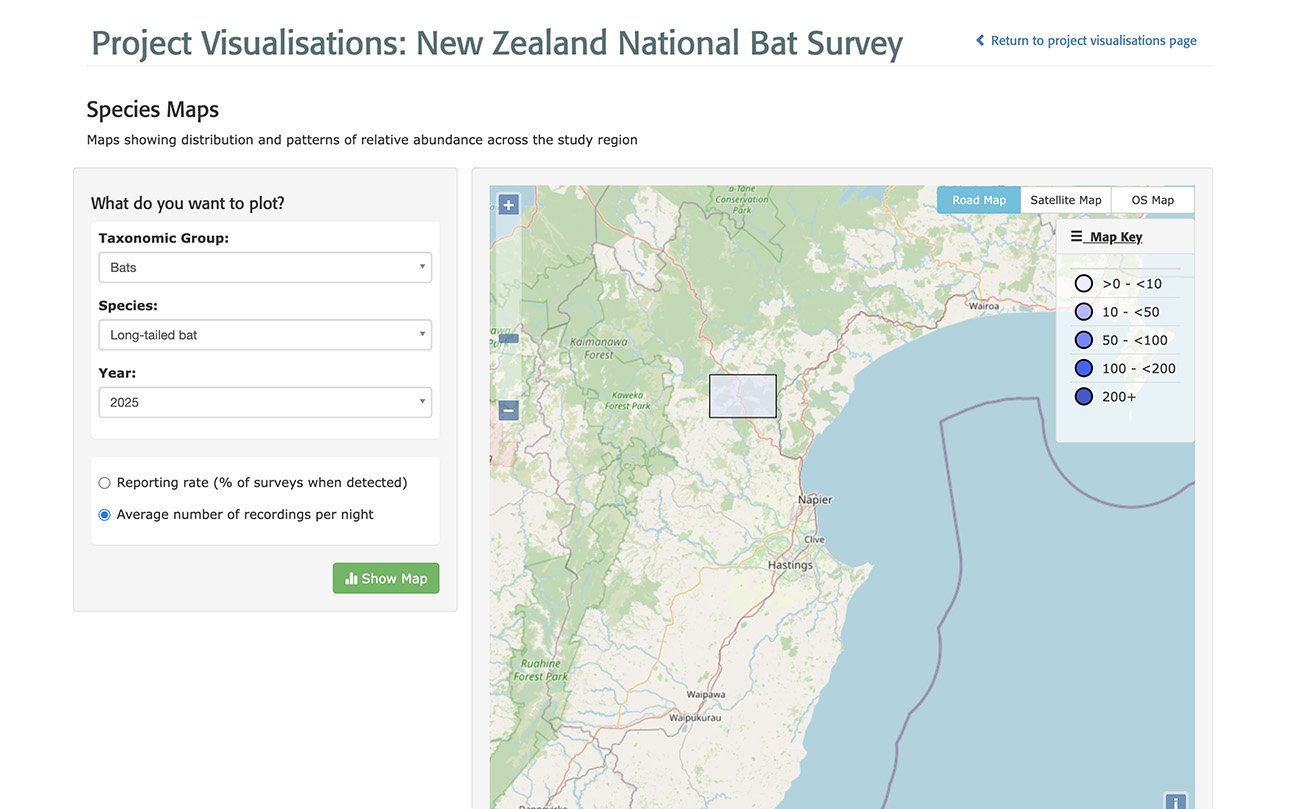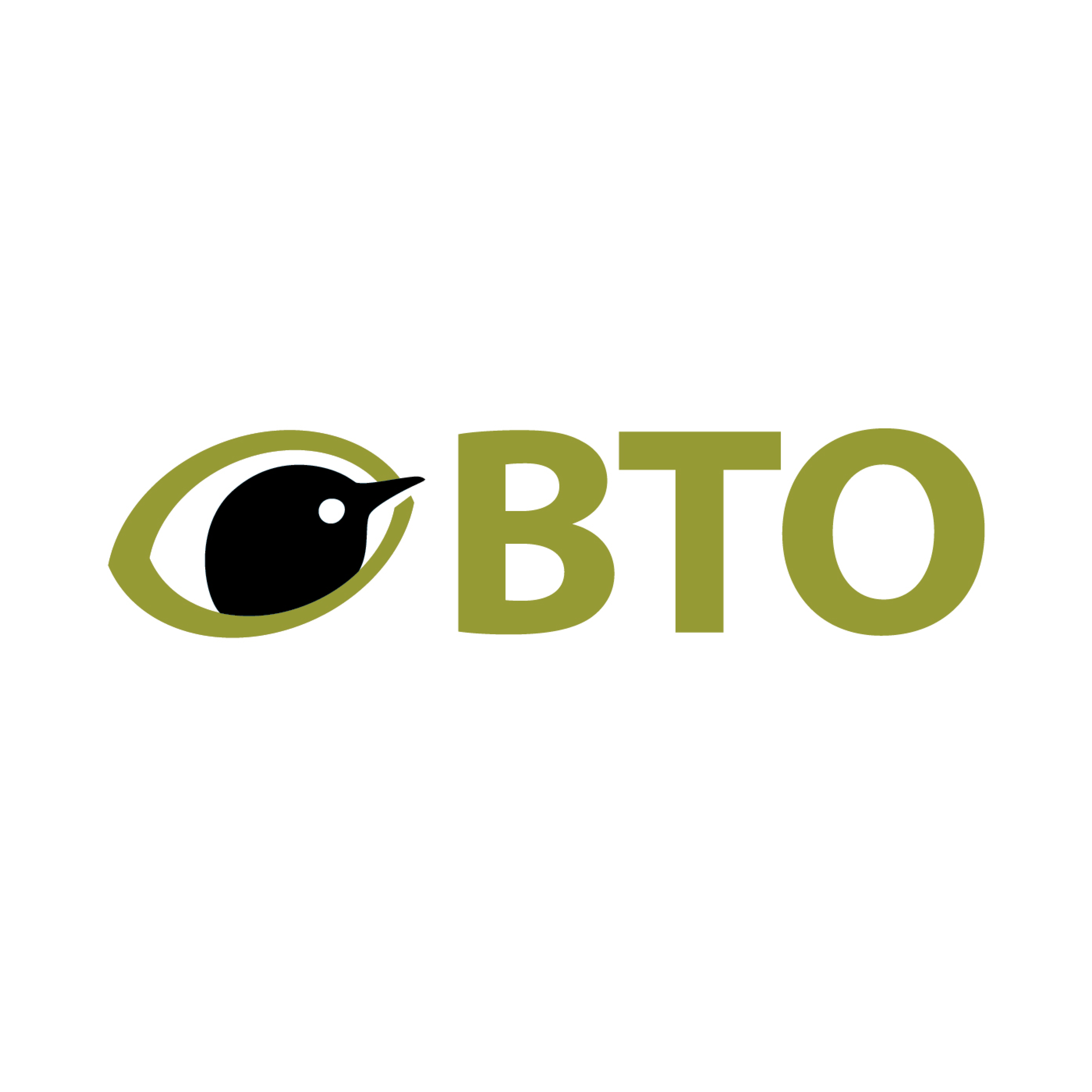
NZ National Bat Survey
Uniting passion and expertise for smarter bat conservation

National surveying stats 2025/26 (not yet started)
Number of project contributors
Number of squares surveyed
Number of sound recordings uploaded
Number of bat calls detected
Join a growing community that's helping to shape the future of bat conservation
Our community brings together enthusiasts, conservation groups, ecology experts, and consultancy clients to monitor bat activity, using our affordable, high-quality detectors and our powerful digital “Bat Pack”. Whether you're just getting started and want to enter the world of bat ecology, or conducting professional ecological assessments that meet regulatory standards, we offer the right tools to get inspired and gather meaningful insights.
For those who want to contribute to our New Zealand National Bat Survey, our Bat Pack allows you to upload your detector’s data to the BTO Desktop App. You’ll receive automated insights sent straight to your inbox and a view of bat activity across New Zealand via our Project Visualisations page. You can see where bats are located, their species, their different calls and more, all of which helps us to better understand and protect them. See what others are discovering, contribute your own findings and join a collaborative effort that’s making bat conservation smarter, stronger and more connected. This year’s annual survey is running from October 2025 to the end of April 2026, although surveys can be run outside of this time.
How to get involved
-

Step 1: Review our detector(s) / Bat Pack(s)
Learn more about our bat detectors, including how they work, key features, and our Bat Pack to help you begin your bat-detecting adventure. You'll also find recommended users and expert tips tailored to each model, making it easy to choose what’s right for your needs.
-

Step 2: Book your survey square(s) and download the Desktop App
For those wanting to contribute to our National Bat Survey, head to our booking map to select your survey square(s). Don’t worry, you can book a spot even if it has been surveyed. From here, download the BTO Desktop App ready to upload your findings.
-

Step 3: Purchase your detector(s)/Bat Pack(s)
Select your detector(s)/Bat Pack(s) and purchase them via our online store. A Welcome Guide email will be sent to you outlining next steps, which are also detailed below and in our Reference Guide. All orders come with free NZ shipping and a money-back guarantee.
-

Step 4: Survey your square(s) and upload your recordings!
Receive your detector and start exploring! Once completed, your Bat Pack will allow you to upload your data to the BTO Desktop App. You will receive a personalised insights report via email, and access to see what others have recorded across New Zealand!
Step 1: Review our detector(s)/Bat Pack(s)
Option 1: The Apodemus Pipistrelle Mini
The Apodemus Pipistrelle Mini is an affordable, easy-to-use active bat detector that lights up and emits sound when bats are nearby. The perfect entry point to bat ecology, this handheld device is ideal for guided bat walks, exploring nature with kids, or for anyone starting out in bat detection. To listen to bat activity without recording, simply plug 3.5mm jack headphones into your detector and tune in to the sounds around you. For a more immersive experience, including visualising, listening to, and recording full-spectrum bat sounds, connect your detector to your phone with a Micro B USB cable and use the FREE Bat Detector App. The app saves your recordings to your phone, so you can replay them at anytime.
If you’d like to contribute to our National Bat Survey, our digital Bat Pack comes FREE with our Apodemus Pipistrelle Mini*. Use the free Bat Detector App above to record your findings. Once you're done, transfer the files from your phone to your computer. Upload your files to the BTO Desktop App (see Step 2), and keep an eye on your inbox for a personalised bat report. It’ll be packed with fascinating insights into bat activity, calls, feeding patterns and more. Want to see the bigger picture? Visit our Project Visualisations page (see Step 4) to explore contributions from others, and come back to our main survey landing page for the latest conservation stats. Detectors come with easy instructions for use.
Note:
Each detector comes with free shipping and a money-back guarantee. If you belong to a group or club and require multiple detectors, get in touch and we will create a budget-conscious package for you. Find answers to common questions on our FAQs page.
Please ensure you read the Welcome Guide email and all instructions to set up your detector correctly.
Keep a note of your preferred detector and you can select it via our store in Step 3.
-
Heterodyne Mode - scanning and manual tuning: The device automatically cycles through a range of frequencies to help detect bat calls at different frequencies. It also converts ultrasonic sounds (which bats use for echolocation and are inaudible to humans) into audible sounds.
Time expansion at 10x, in Real Time Expansion mode: The bat call is slowed down by a factor of 10. This makes the call audible and allows you to hear fine details like frequency modulations and structure, which are important for species identification.
Spectrum Display: This provides a real-time visual representation of the ultrasonic sounds picked up by the bat detector.
Spoken Frequency settings: English
Frequency range: 10 - 110kHz
Sample rate: 384kHz
Headphones: 3.5mm headphone jack (headphones not included)
Connector Port: Micro B USB (to connect your detector to your phone)
Battery: 3 x AAA batteries (not included)
Size: 70 x 56 x 23mm
Weight: 30g (excluding batteries)
Warranty: 2 years for manufacturing faults. This warranty does not cover moisture damage or external mechanical damage
Who is it suitable for?
-
Empower your group to rapidly identify where bats are active within your survey area, using our plug-and-play Apodemus Pipistrelle Mini detector. Cost-effective, automated and with no prior bat survey experience required, this detector is ideal for volunteers or local groups wanting to collectively contribute to bat monitoring in New Zealand.
-
Join a nationwide bat detecting movement and play a hands-on role in conserving native nocturnal wildlife. Designed for aspiring ecologists, our Apodemus Pipistrelle Mini lets you detect real-time bat activity in your area. You'll gain practical field experience, contribute valuable data, and see the real impact of your efforts on local conservation.
-
Getting kids involved with our bat detectors is a fun and accessible way to encourage curiosity, build awareness of local biodiversity, and can even inspire future conservationists. The detectors are ready to use straight out of the box, with no prior experience needed, making them perfect for young explorers. As they listen for bat calls and identify when they fly nearby, children are introduced to the hidden world of nocturnal animals in an exciting, hands-on way.
This is a general guide only. We recommend choosing a detector based on your specific needs, preferences and goals.
*If professional or complex surveying is required, Bat Packs must be bought separately due to data usage.
Step 1 - Option 2: The Demeter Detector
The Demeter Detector is a compact and cost-effective passive bat detector to be placed and left out in the field for extended periods. This detector is ideal for consultancy projects, researchers, and conservationists. It offers 200 hours of high-quality, full spectrum audio recording capabilities, making it perfect for monitoring bat activity. Delivered fully assembled, programmed, and tested, the Demeter features a one-button user interface and lightweight design, with a waterproof enclosure for operation in damp or wet environments. Paired with our digital Bat Pack, it supports compliance, planning decisions, and biodiversity outcomes, allowing you to gather regulator-ready bat data delivered fast and affordably. Simply load your detector with an SD card, capture your recordings, transfer the files from the SD card to your computer, then upload to the BTO Desktop App (see Step 2) using your Bat Pack access, to process. You’ll receive a personalised report via email within 48 hours, featuring valuable information into bat activity. You can also see how others are contributing to the survey via our Project Visualisations page (see Step 4), plus keep a track of our key conservation stats here on our main survey landing page. Detectors come with easy instructions for use.
Note:
The purchase of a Bat Pack is required to process data from the Demeter Detector via the BTO Desktop App. Each detector comes with free shipping and a money-back guarantee. For queries get in touch, or find answers to common questions on our FAQs page.
Please ensure you read the Welcome Guide email and all instructions to set up your detector correctly.
Keep a note of your preferred detector and you can select it via our store in Step 3.
-
High-Quality Data Capture: Records rich, reliable acoustic data for both birds and bats in various field conditions.
Static, Weather-Resistant Design: Built for long-term, unattended deployment in the field.
User-Friendly Operation: Easy to set up and use, with minimal training required.
Efficient Data Processing: Seamlessly integrates with our Bat Pack for rapid analysis and reporting.
Cost-Effective Solution: Delivers professional-grade results without high-end equipment costs.
Versatile Monitoring: Suitable for ecological surveys, impact assessments, and research projects.
Compact and Portable: Lightweight and easy to transport between field sites.
Low Power Consumption: Optimised for extended deployment with minimal maintenance.
Advanced configurations and sleep modes to save battery.
Consistent time keeping for up to five years.
Files encoded with GUANO data for easy analysis.
Advanced triggering functions to save SD card space.
Battery: 4 x AA batteries (not included)
Sample rate: Configurable 16kHz, 48kHz, 96kHz, 192kHz, and 364kHz
Storage: SDHC OR SDXC card (not included)
Recording capacity: Up to 200 hours
Size: 63 × 57 × 25mm
Weight: 40g (excluding case and batteries)
Who is it suitable for?
-
For field data collection, our static Demeter Detector offers a fast, affordable way to capture empirically robust and insightful results. When paired with our Bat Pack, you’ll benefit from rapid data processing and in-depth reporting, summarised from all devices when using the same account to upload recordings. This is ideal for groups who wish to survey multiple points within their survey area.
-
As an experienced ecologist, the Demeter Detector enables you to produce high-quality, data-rich results quickly and affordably, reinforcing your reputation for delivering effective outcomes. Whether you're managing a large-scale biodiversity project or showcasing your expertise in new areas, this detector along with our Bat Pack allows you to detect bat activity rapidly, analyse and map results automatically, and present professional-grade data. All achieved without time-consuming data analysis and post-processing headaches.
-
Obtain rapid, reliable insights into bat activity with mapped and analysed data, designed to meet regulatory standards, inform Environmental Impact Assessments and support robust biodiversity planning. Our comprehensive turnkey service includes our Demeter Detector, full setup guidance for you or your contractor, with all technical aspects managed by our team, no prior expertise required.
This is a general guide only. We recommend choosing a detector based on your specific needs, preferences and goals.

Step 1 - Option 3: Our “Bat Pack”
Our digital Bat Packs, together with our detectors, are designed to inspire New Zealanders to take responsibility for these often-overlooked nocturnal species, and the habitats on which they depend. Record nighttime sounds with your detector, then upload your recordings to the BTO Desktop App using your Bat Pack access, where results are analysed and transformed into a personalised report within 48 hours. You’ll receive your report via email, complete with detailed insights into your findings. You can also explore how others are contributing through our Project Visualisations page (see Step 4), and stay up to date with key conservation stats here on our main survey landing page. Your contribution will be added to our National Bat Survey, helping to build a collective picture of bat populations across the country and demonstrate the impact of citizen science on conservation. The experience is accessible to anyone, regardless of expertise.
Read more on the amazing benefits and features via the Key Specs below.
One Bat Pack is needed for each detector and has an annual cost. Once a Bat Pack has been obtained, your access is automatically updated. Please ensure you read the Welcome Guide email and all instructions to upload your data correctly.
If you have your own detector and only require Bat Packs, these can be purchased from our store in Step 3.
-
The Bat Pack includes:
A data pack to upload your recordings to the BTO Desktop App.
Access to custom reporting with fascinating insights tailored to your findings, with a 48 hour data processing turnaround.
Interactive survey maps where you can view other user contributions.
Key project stats and updates.
Compatible with your own detectors.
Key benefits and features:
Powerful data processing allows for multiple bat species that present to be identified in each recording, not just the bats with the strongest signals. This means that quieter bat species have the opportunity to be identified.
There is separate identification for bat echolocation calls, social calls and feeding buzzes, not only helping to identify species but feeding patterns, proximity to roosts and mating behaviours.
Project specific visualisations allow you to see summaries of species at various recording sites, activity timing and activity mapping.
The special reporting algorithm was developed in the UK by Dr Stuart Newsom and Dr Simon Gillings in collaboration with experts throughout Europe. We are now bringing this exciting world of bat surveying to New Zealand.
Step 2: Book your survey square(s) via the booking map and download the Desktop App
Before purchasing your detectors, secure your survey square(s). Click the image below and head to our booking map. Click the Login button at the bottom of the page to sign in, or create a new account via the Register for MyBTO button. Once you’ve registered, find the location you’d like to survey on the map, zoom in to see the surveying squares, double click the square you’d like to survey and click request. You can request additional squares if you’d like to survey more than one spot, by repeating the previous step. To see your survey squares, head to Manage My Bookings. You can return to your bookings here at any time.
This year’s survey is running from October 2025 to end of April 2026. Don’t worry if a survey square has already been taken, you can still survey that area. Make sure to come back and select your detectors/Bat Packs so that you are ready to start your bat-finding journey.
Once you’ve booked your surveying square(s), you can download the BTO Desktop App for FREE, ready to upload your recordings! Click the screen below, login and download the app for Windows or Mac. You don’t need to do anything else at this point, until after you have used your detector.
Step 3: Purchase your detector(s)/Bat Pack(s)
Select your preferred detectors, Bat Packs and quantities of each below. A reminder that a Bat Pack is needed for each detector purchased, unless bundled for free with the Apodemus Pipistrelle Mini. For assistance with determining how many detectors/Bat Packs are needed or for general enquiries, please contact us.
Step 4: Survey your square(s) and upload your results!
Once you have finished detecting, head to the BTO Desktop App and sign in using your account details. Click the Start button under the “Detect and identify bats…” section. A new screen will appear - click the Start New Upload button and follow the steps to upload your recordings. Once upload is complete, you will receive an email to let you know that your results are ready, and a link to view your report.
To see your findings and what others have collected, head to the Project Visualisations: New Zealand National Bat Survey page via the button below. You can view reports on coverage, long-term trends, hourly patterns of bat behaviour and our species map.
Top tips for bat detecting
-

Planning
Best locations: Look near old or large trees, bush edges, roads, or gaps in forested areas, these are common feeding routes for bats.
When to go: Bats usually emerge just after sunset, but it can take up to 30 minutes to appear.
Where to stand: Find a spot under tall trees with a view of the sky, you’ll have a better chance of spotting bats silhouetted against the dusk.
-

Minimise Disturbance
Keep quiet: Bats are sensitive to noise, speak and move quietly.
Use red light: Avoid bright torches. Use a red lens torch or cover yours with red cellophane.
No pets: Leave your dog at home to avoid startling wildlife.
Respect the space: Many bat sites are near residential areas, please be considerate of others and avoid disturbing nearby homes.
-

Using your detector
Check your batteries: Bring spares just in case.
Point it right: Detectors are directional, so point them slightly up and away from you. Bats within 20–30 metres will be easier to detect.
Listen for feeding buzzes: When a bat is closing in on prey, its calls speed up, forming a “buzz” sound. This is a great clue that there’s feeding behaviour.
-

Safety first
Scout the area by day: Particularly if you're unfamiliar with the site. Make sure wherever you choose is safe to stand when you are using your detector.
Stay on tracks: Especially near rivers, gullies, or steep terrain. It can be easy to lose your footing.
Dress appropriately: Bring warm, waterproof clothing, sturdy footwear, a torch, insect repellent, and a first aid kit.
Document library
Our document library features a curated collection of user guides, surveying guides, and other helpful resources designed to support you on your bat detecting journey. Whether you're setting up your detector for the first time or planning a night-time survey, our guides provide clear, step-by-step instructions and expert tips to ensure you get the most accurate and meaningful results.
Have questions?
Check out commonly asked questions about our projects, detectors, Bat Packs and more via our FAQs page below.
-
New Zealand is home to three species of endemic bats (pekapeka), our only native land mammals. These fascinating nocturnal creatures are shy, elusive, and play a vital role in our ecosystems, but are also at serious risk of extinction.
Long-tailed bat (Chalinolobus tuberculatus)
Status:Nationally Critical.
The long-tailed bat is the species you’re most likely to detect. It is widespread across both the North and South Islands, and can also be found on offshore islands such as Rakiura/Stewart Island, Little Barrier Island, and Kāpiti Island. It has been recorded in urban areas, including parts of Auckland, Hamilton, and Rotorua.
Habitat: Roosts in old hollow trees and forages along bush edges, roadsides, and forest gaps.
Behaviour: Flies fast and erratically, emerging around dusk. It covers large home ranges, making sightings brief but exciting.
Detecting tip: Look along bush edges or open tracks—places like Talbot Forest in Geraldine are known hotspots.
Lesser short-tailed bat (Mystacina tuberculata)
Status: Subspecies range from Nationally Vulnerable to Recovering.
This ancient and unusual bat is found only in a few places, including Northland, Taranaki, and Whenua Hou/Codfish Island near Rakiura. Unlike most bats, it spends significant time on the forest floor, foraging like a mouse for insects and fruit.
Habitat: Dense native forest, where it roosts in tree cavities and forages under leaf litter.
Behaviour:More reclusive and harder to detect due to its terrestrial habits. It is particularly vulnerable to predators like rats and stoats.
Detecting tip: It may be harder to pick up without long-term monitoring tools like passive detectors in remote bush areas.
Greater short-tailed bat (Mystacina robusta)
Status:Thought to be extinct.
Last known from two islands off Rakiura/Stewart Island, this species hasn't been reliably sighted for over 50 years. Although occasional reports emerge, it is likely extinct. Conservationists continue to hold hope for rediscovery, but none have yet confirmed its survival.
-
No. You can create one account and upload all of your detector results via the BTO desktop app, to get a summary of collective results. Nice and easy!
-
Yes! For those who are starting out in detecting, your backyard can be a good place to begin. Bats are attracted to more mature trees, especially natives such as pūriri and tōtara. You may not detect activity every night, so try over a period of time and if nothing appears, you might want to try another local, safe area to detect from.
-
If you live in an area where bats are present, you can take simple steps to make your garden a welcoming and safe space for them. Here’s how to help support these unique native mammals:
Create a safe environment:
Control pests: Eradicate pests like rats, which can harm bats and disturb their roosts.
Keep cats indoors at night: Domestic cats are natural hunters and can pose a serious threat to bats, especially when they’re emerging from roosts or foraging low to the ground.
Support natural roosting sites:
Plant native trees: Choose species with gnarly bark and natural hollows, such as:
Pūriri (Vitex lucens)
Tōtara (Podocarpus totara)
Pukatea (Laurelia novae-zelandiae)
Cabbage trees (Cordyline australis) – bats often roost in their hollows.
Remove invasive weeds: Clear out aggressive species like moth plant and climbing asparagus, which can choke large trees and reduce suitable roosting spots.
Install Bat Boxes:
Add roost boxes to your property: These can provide artificial shelter, especially where natural roost sites are limited.
Install carefully: Bats prefer roosts that are high up in mature trees, so height and location matter for success.
By taking these actions, you can turn your garden into a mini haven for bats, contributing to their conservation while enjoying their quiet, nocturnal presence.
-
Yes, if you need help determining how many detectors or Bat Packs you need, have issues with uploading, or general queries about your detectors, please contact us for assistance.
-
Apodemus Pipistrelle Mini:
2 years for manufacturing faults. This warranty does not cover moisture damage or external mechanical damage.
-
Shipping is free on all orders, and is available within New Zealand only. All orders come with a money-back guarantee. If you're not satisfied, please reach out for a refund or replacement.

